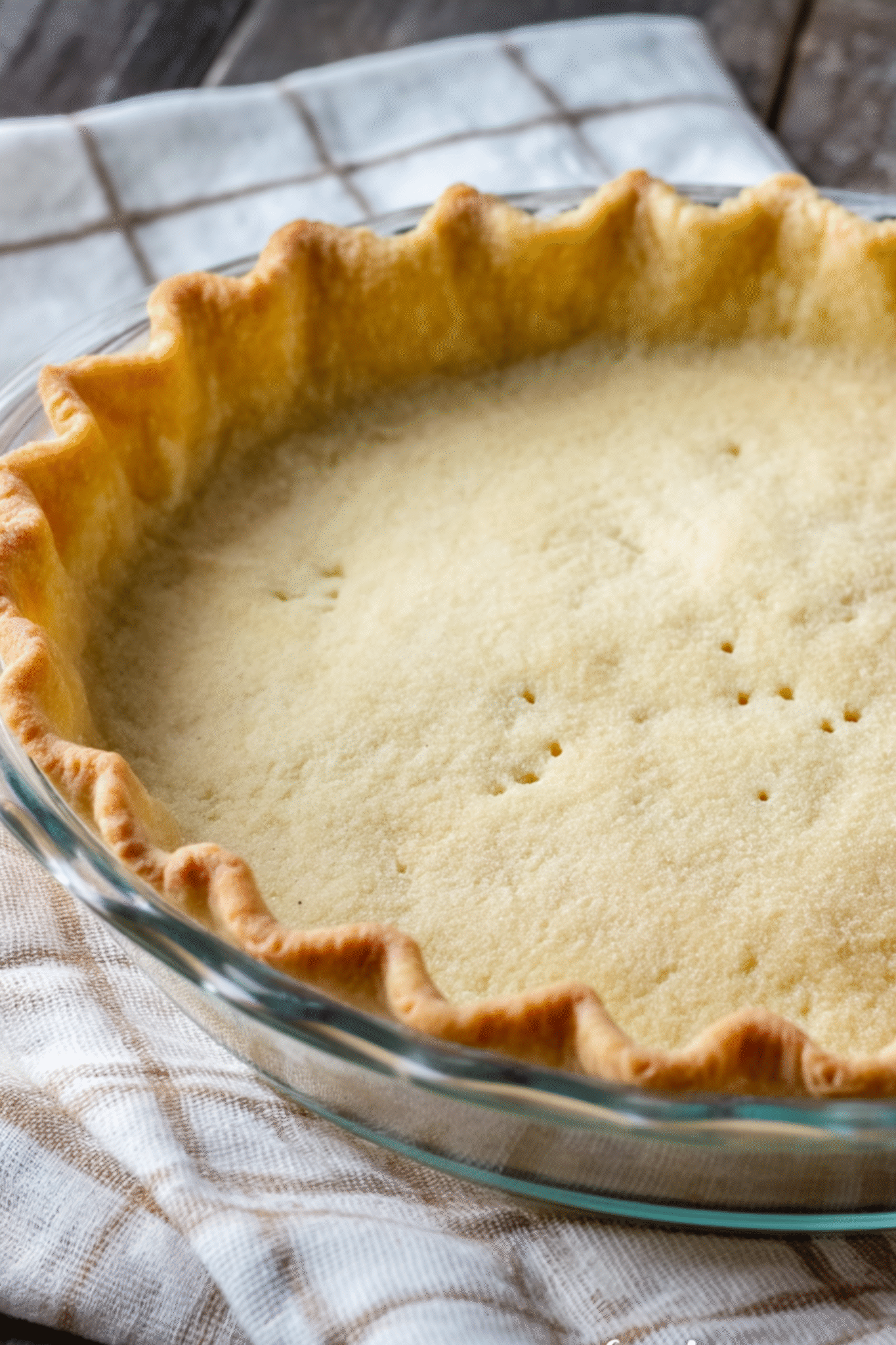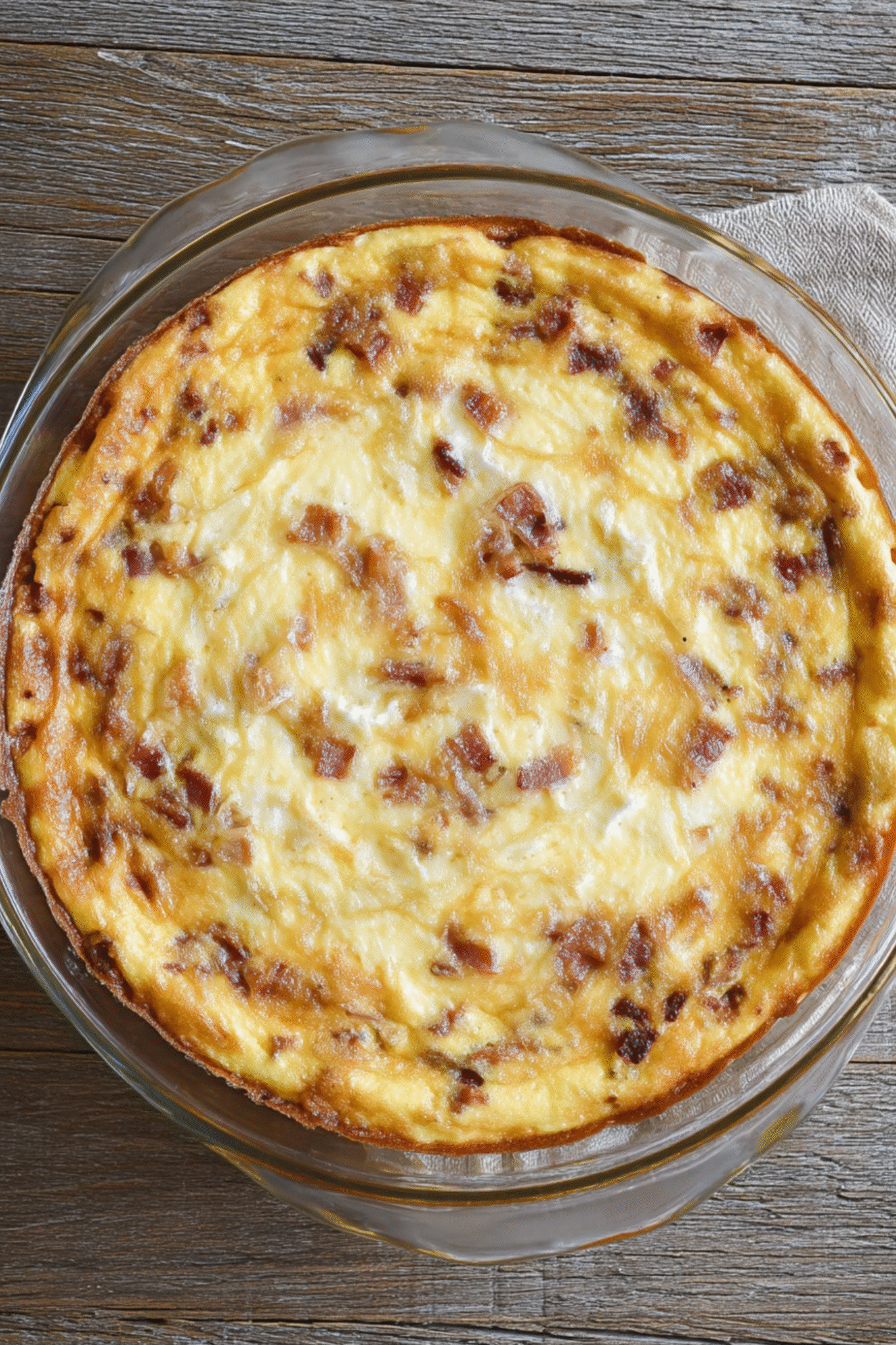There’s something about tabbouleh salad that makes it feel like home—bright, fragrant, and refreshingly simple. This Middle Eastern dish, brimming with parsley, mint, lemon, and bulgur, has long been a staple in my kitchen. In this article, you’ll discover the story behind this beloved salad, how to make it authentically, why it’s incredibly good for you, and the perfect pairings that make it shine even more. Whether served as a side or the star of the table, tabbouleh salad always brings joy and vibrancy to every bite.
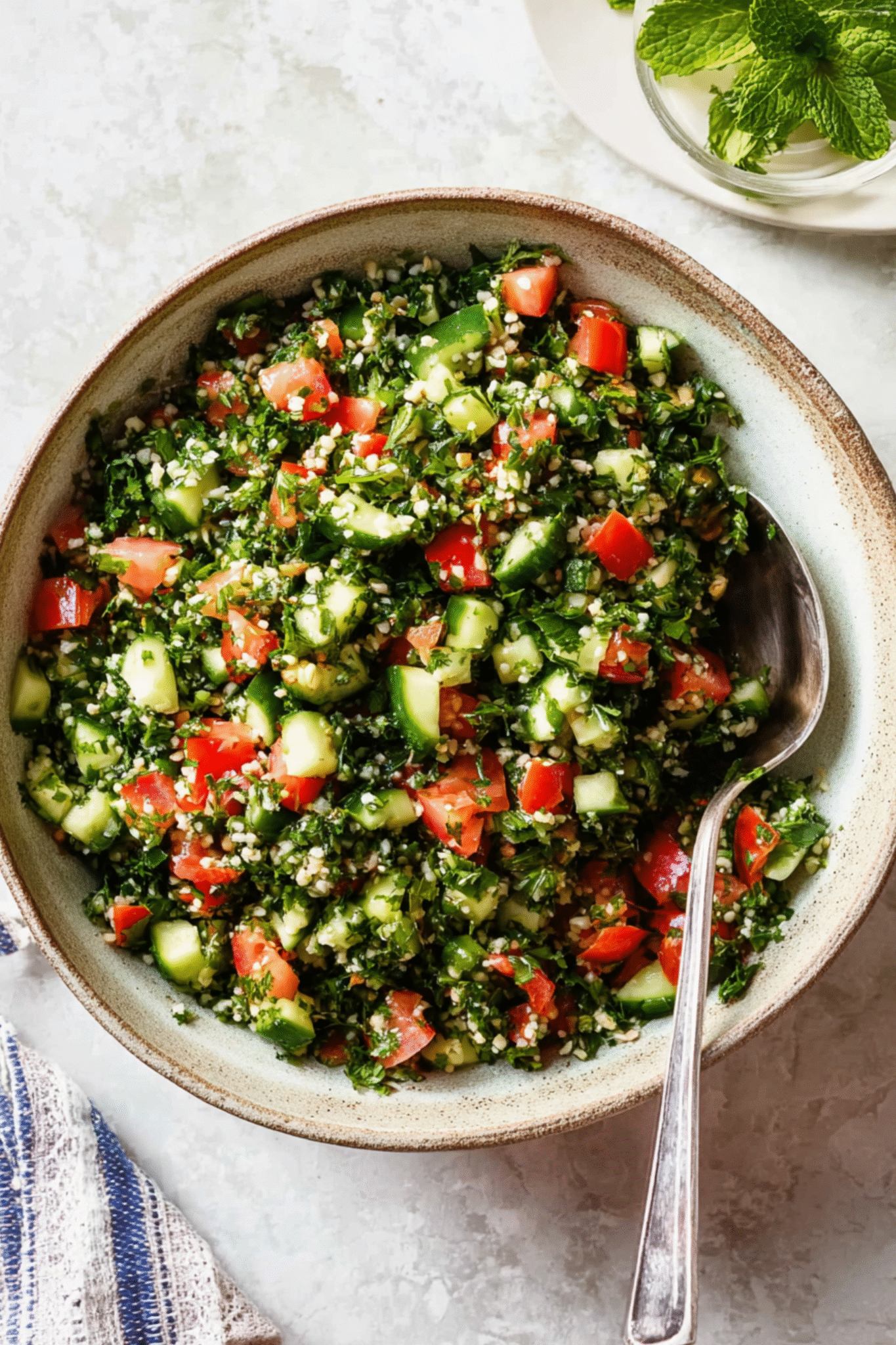
Table of Contents
The Story Behind Tabbouleh Salad
My First Taste of Tabbouleh in Naples
Back in Naples, where I grew up, summers meant a bowl of tabbouleh on the terrace, the scent of lemon and mint drifting in the warm air. My mother, who had learned to make it from her Lebanese neighbor, would chop parsley by hand until her fingers were stained green. I’d sit beside her, stealing bits of tomato and dipping pita in the bowl before it was done. She always said, “Ivana, tabbouleh is like a garden on your plate—fresh, delicate, and alive.”
That memory traveled with me to New York, where I found myself making this exact salad during pop-ups and wedding caterings. People loved its brightness. I’d often hear, “This tastes like something I didn’t know I missed.” That’s the magic of tabbouleh salad—it’s humble, herb-forward, and deeply comforting.
In my blog’s early days, this was one of the first dishes I knew I had to share. It’s not just a recipe. It’s a story of warmth, hospitality, and the kind of simple food that brings people together.
You can find this same spirit in my fresh Arabic Salad or when I serve it with Cauliflower in the Air Fryer with Lemon and Cumin, perfect partners to tabbouleh.
A Salad Rooted in Heritage and Simplicity
Tabbouleh salad (or tabouli) comes from the Levant—especially Lebanon and Syria—where it’s traditionally served as part of a mezze spread. Unlike Western salads that focus on lettuce or grains, tabbouleh places parsley front and center. Lots of it. Fresh mint adds a cooling note, while ripe tomatoes, scallions, and a drizzle of lemon-olive oil dressing balance everything out.
The classic version uses fine bulgur wheat—soaked, not cooked—just enough to add texture without taking over. The result is light, vibrant, and slightly tangy. Every spoonful bursts with herbs, citrus, and a touch of earthy grain. That’s the beauty of tabbouleh salad: minimal ingredients, big flavor, and nothing fussy.
It’s a recipe passed down through generations, made not by measuring but by feeling. You taste, adjust, and trust your delicious hand. That’s what makes it special.
What Makes a Perfect Tabbouleh Salad
The Freshest Ingredients Make All the Difference
If there’s one golden rule when making tabbouleh salad, it’s this: freshness isn’t optional—it’s everything. Tabbouleh isn’t the place for limp herbs or overripe tomatoes. Every ingredient plays a lead role, especially the parsley. Choose curly parsley (not flat-leaf) and chop it very finely. It should form the base of your salad—not just garnish the top.
Tomatoes should be firm, ripe, and juicy, but not too wet. Dicing and letting them sit on a paper towel helps avoid excess moisture that could water down the salad. English cucumber adds a refreshing crunch and holds up better than other types.
Fresh mint is what gives tabbouleh its signature lift—it shouldn’t overwhelm but should be present. And scallions bring a mild, oniony brightness that balances the flavors beautifully.
The grain of choice is traditionally fine bulgur wheat. It’s nutty, soft, and absorbs the lemony dressing well. A little goes a long way—you’ll only need ⅔ cup of cooked bulgur here. If you’re interested in lower-carb or gluten-free options, you can easily substitute it with quinoa, though it will slightly change the texture.
The dressing is no afterthought: extra-virgin olive oil, lemon juice, garlic, sea salt, ground coriander, and a hint of cinnamon. That pinch of warm spice isn’t traditional in every recipe, but it rounds out the flavor and complements the herbs beautifully.
The whole salad should taste vibrant, lemony, and herb-forward—never oily or grain-heavy. When you get it right, every bite should feel clean and light.
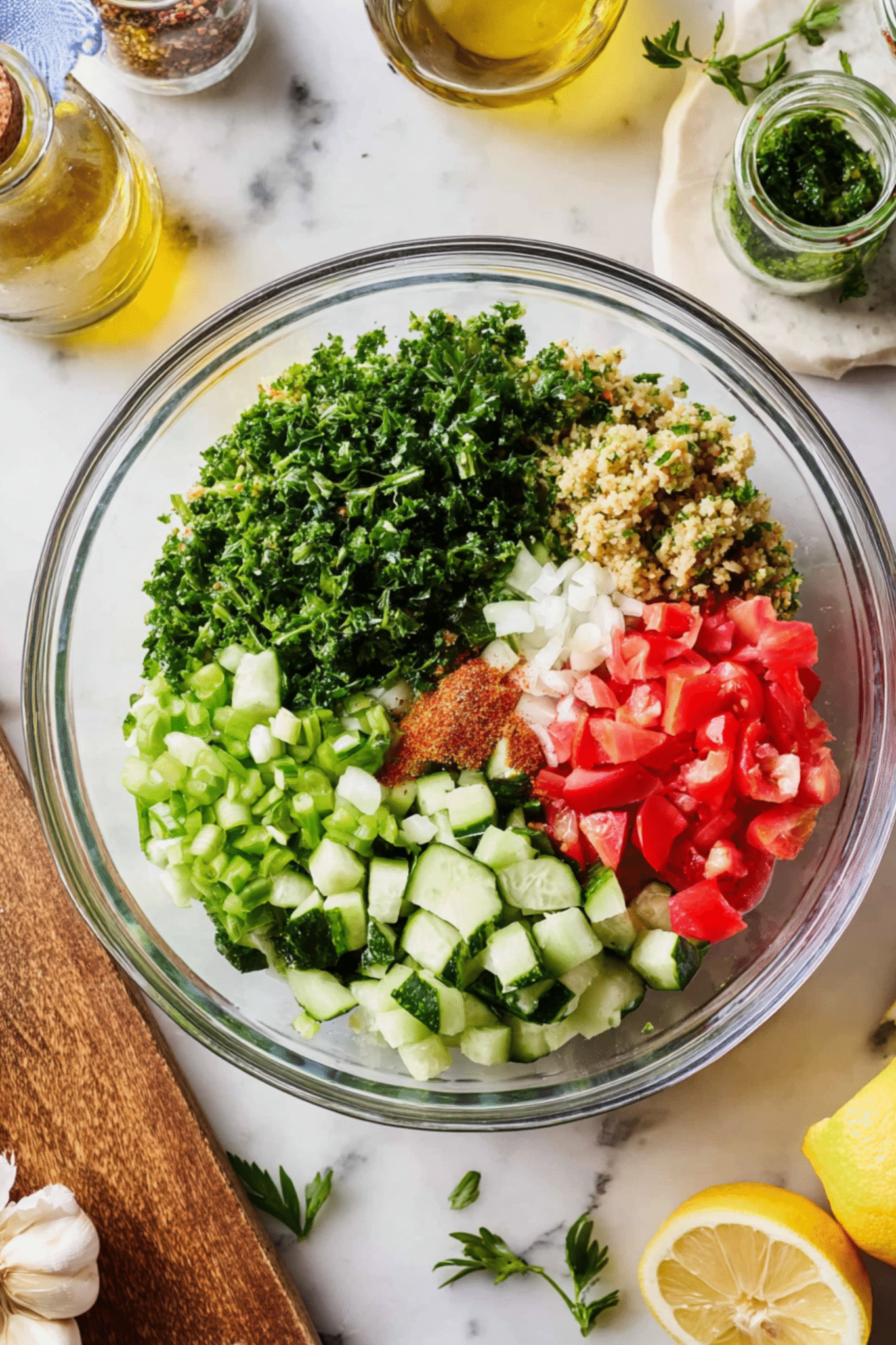
How to Chop and Toss Like a Pro
Tabbouleh salad isn’t difficult, but it does require some finesse—particularly in the chopping. Think of it as meditative prep: everything needs to be finely, evenly chopped so the salad eats like a cohesive blend, not a chunky mix.
Use a very sharp knife or a mezzaluna if you have one. Avoid food processors—they’ll bruise the herbs and make the salad soggy. Wash your parsley thoroughly and dry it completely with a salad spinner or clean towel. Wet herbs lead to mushy results.
Bulgur should be fluffy, not wet. If you cook it, drain it well. If soaking, just cover it with boiling water, let it sit, then squeeze out any excess liquid before adding it to the bowl.
Once everything’s prepped, mix the dressing first in a large bowl. Then add parsley, mint, cucumber, tomato, scallions, and bulgur directly into the bowl. Toss gently with tongs or clean hands. Taste and adjust with more lemon, salt, or olive oil as needed.
The final salad should be light, not weighed down by grains or oil, and it should look like a green mosaic. For best results, let it chill for 30 minutes before serving to allow the flavors to meld.
If you enjoy colorful herb-based sides like this, you might also love the Shopska Salad, a Balkan cousin bursting with freshness and feta. Or try it alongside a cool bowl of Thermomix Gazpacho to complete a warm-weather spread.
Why Tabbouleh Salad Is So Good for You
A Bowl Full of Nutrients and Fiber
Tabbouleh salad isn’t just a flavorful addition to your table—it’s a nutritional powerhouse in disguise. Packed with herbs, veggies, healthy fats, and whole grains, it supports a wide range of health benefits while tasting incredibly fresh.
Let’s start with parsley. This isn’t just a garnish—parsley is rich in vitamins A, C, and K, which support immune function, skin health, and bone strength. It’s also a natural anti-inflammatory and full of antioxidants. And because tabbouleh uses three full cups of it, you’re not getting a sprinkle—you’re getting a true dose.
Next, there’s bulgur wheat, which brings complex carbohydrates, fiber, and plant-based protein to the mix. Unlike refined grains, bulgur is a whole grain that supports steady energy levels and digestive health. And with less than ⅔ cup per bowl, it complements the herbs without overpowering the salad.
Cucumbers and tomatoes add hydration, vitamin C, and lycopene—a heart-healthy antioxidant found in red and pink produce. Scallions offer sulfur compounds that may support liver health and digestion. And don’t underestimate the olive oil—its monounsaturated fats help absorb fat-soluble nutrients and support brain and heart health.
Mint adds more than just a fresh taste—it can aid digestion and offer antimicrobial benefits. Paired with garlic and lemon juice, this salad does a quiet dance between flavor and function.
Altogether, tabbouleh salad is:
- High in fiber
- Naturally vegan
- Rich in vitamins and antioxidants
- Low in calories but satisfying
- Gluten-optional (more on that below)
No surprise people are asking, Is tabbouleh healthy? The answer: absolutely yes—and it’s deliciously easy to love.
Gluten-Free & Vegan? Easy Substitutions
If you’re cooking for a gluten-free guest or simply want to switch things up, quinoa is an excellent substitute for bulgur wheat. It has a slightly nuttier flavor, a firmer texture, and offers more complete protein per serving—making your tabbouleh even more filling.
Another good option is cauliflower rice, which keeps the salad low-carb and grain-free. Just be sure to steam or microwave it briefly and let it cool before using.
The dressing is already vegan—extra-virgin olive oil, lemon, garlic, and spices. But if you’re adding tabbouleh to wraps or bowls, double-check your pairings to keep everything plant-based.
Tabbouleh also works well in make-ahead meal prep. Just store the dressing separately and mix before serving to preserve the freshness. It lasts up to 3 days in the fridge and actually tastes better after resting for a few hours.
Want to pair it with something hearty yet still healthy? Try it next to this Easy Lamb Mince Ragu for a satisfying, Mediterranean-inspired dinner. Or spoon it into a wrap with some Cilantro Chimichurri for a zippy lunch that packs flavor and nutrients.
No matter how you serve it, tabbouleh salad is proof that good-for-you food can also be crave-worthy.
What to Serve with Tabbouleh Salad
Mezze Magic – The Perfect Companions
Tabbouleh salad may be simple, but it knows how to play well with others. In Middle Eastern cuisine, it often shines as part of a mezze platter—a small-plate feast designed for sharing. If you’ve ever sat at a table brimming with colorful dishes, flatbreads, dips, and pickled veggies, you know the joy of mezze.
Serve your tabbouleh alongside creamy hummus, smoky baba ganoush, and cool labneh (strained yogurt cheese) for a classic lineup. Add warm pita or flatbread to scoop it all up, and a few olives or pickled turnips to balance the freshness.
Dolmas (stuffed grape leaves) and falafel bring texture and richness that pair beautifully with tabbouleh’s lightness. For an even more colorful spread, toss in this zesty Arabic Salad—it mirrors tabbouleh’s freshness but adds its own tomato-forward flair.
If you’re going grain-free or low-carb, tabbouleh also works beautifully in lettuce cups or spooned over roasted eggplant slices. The brightness of the herbs lifts even the most savory dish on the table.
You can also use it as a topping for warm chickpeas, adding a zesty layer to the earthy legumes. This combination alone can stand as a protein-rich vegan main dish.
And don’t forget the drink: tabbouleh loves mint tea, light white wines, or sparkling water with lemon.
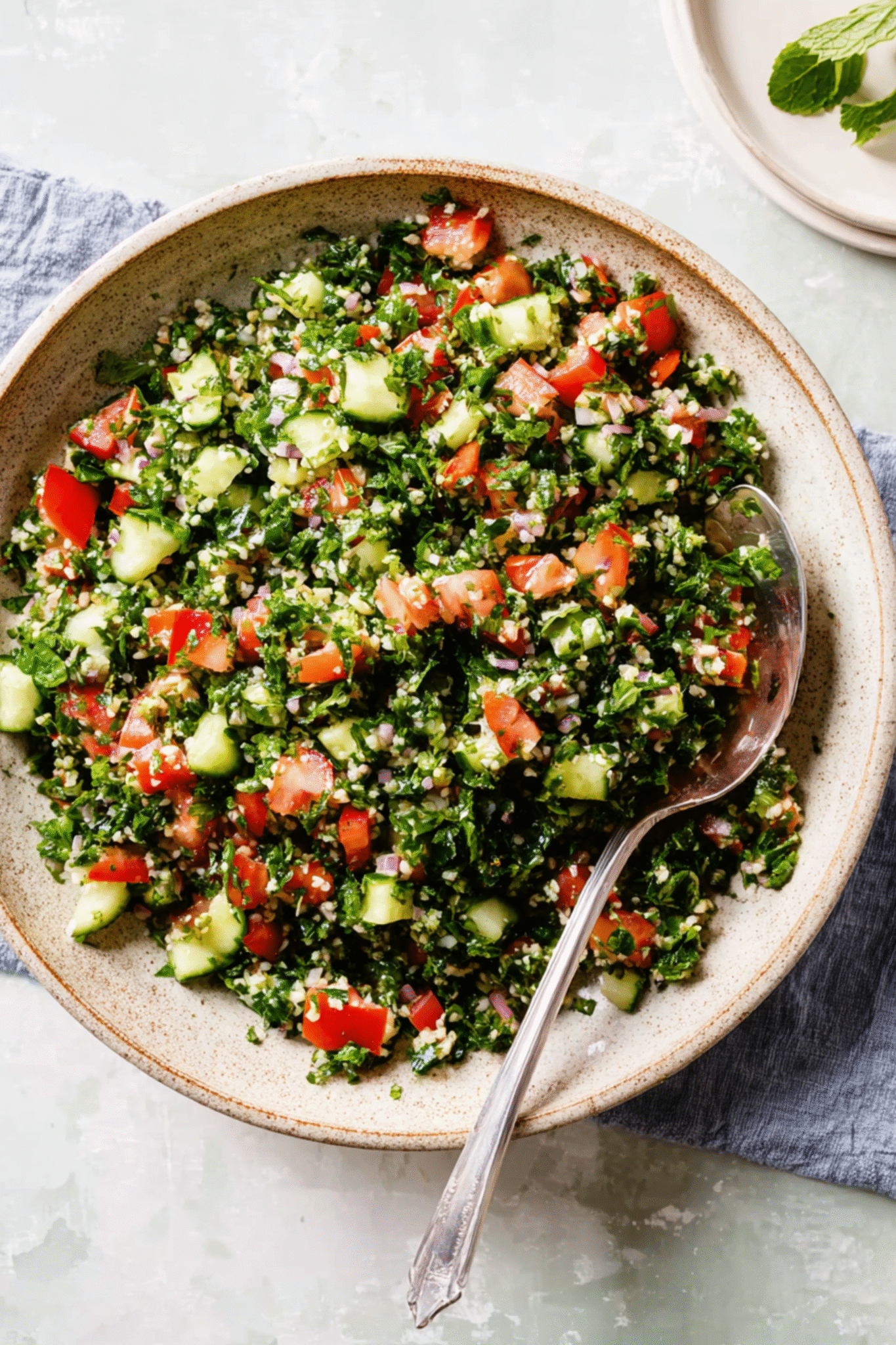
Tabbouleh as a Modern Side Dish
While mezze is traditional, don’t limit your tabbouleh salad to Mediterranean menus. It works beautifully as a modern side dish for all kinds of meals, especially grilled mains. Think lemon herb chicken, lamb skewers, grilled shrimp, or even a seared salmon fillet.
Tabbouleh also makes a lively addition to bowls—layer it over quinoa, lentils, or chickpeas with roasted veggies and a drizzle of tahini dressing. You can also stuff it into pita or wrap it in flatbread with some crumbled feta or falafel for a lunch that travels well.
For brunch lovers, try it next to a slice of this Spinach and Feta Crustless Quiche, where the salad’s brightness cuts the richness of the eggs and cheese.
Even unexpected pairings can work. Ever had tabbouleh with grilled steak or roasted sweet potatoes? The lemony freshness provides the perfect contrast to bolder flavors.
And if you’re looking for a low-effort but crowd-pleasing dinner idea, pair tabbouleh with something cozy like the Keto Chicken Caesar Salad—a mix of hearty and herbaceous that keeps the whole table happy.
Ultimately, tabbouleh’s superpower is versatility. It’s light enough to refresh a heavy plate, bold enough to stand on its own, and flavorful enough to complement almost anything you serve.
FAQs About Tabbouleh Salad
Is tabbouleh healthy?
Yes, tabbouleh is incredibly healthy. It’s packed with fresh herbs like parsley and mint, which are high in antioxidants, vitamins A, C, and K. With bulgur wheat adding fiber and slow-digesting carbs, plus heart-healthy fats from olive oil, it’s a low-calorie, nutrient-dense dish that supports digestion, immunity, and energy.
What goes with tabbouleh salad?
Tabbouleh salad pairs well with other Mediterranean dishes like hummus, baba ganoush, falafel, and grilled meats. You can also serve it alongside soups, wraps, roasted vegetables, or dishes like Arabic Salad or Spinach and Feta Crustless Quiche for a colorful, satisfying meal.
Is tabouli salad good for you?
Absolutely. Tabouli (or tabbouleh) is naturally vegan and full of anti-inflammatory herbs, fresh vegetables, and whole grains. It supports gut health, hydration, and provides essential micronutrients without added sugars or processed ingredients. It’s a feel-good salad that’s also satisfying and easy to digest.
Why is it called tabbouleh?
The name “tabbouleh” comes from the Arabic word “taabil,” which means “to season” or “to spice.” That’s fitting because tabbouleh is all about fresh, seasonal ingredients seasoned simply but effectively. It’s a traditional dish in Levantine cuisine, especially in Lebanon and Syria, where it has been passed down for generations.
Conclusion
Tabbouleh salad is so much more than a side dish—it’s a celebration of fresh herbs, zesty lemon, and wholesome ingredients that come together in perfect harmony. Rooted in tradition but endlessly adaptable, it offers a refreshing break from heavy meals while delivering a powerful nutritional boost.
For me, it’s a taste of home—a reminder of sun-drenched afternoons in my mother’s kitchen, hands covered in parsley, heart full of joy. I hope this recipe brings the same warmth and flavor to your kitchen.
If you enjoyed this, I’d love for you to join me on social! Follow me on Facebook and Pinterest for more fresh, soulful recipes and stories from my NYC kitchen.
From my table to yours—buon appetito!
Print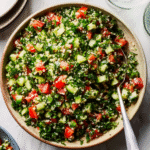
Keto Tabbouleh Salad
- Total Time: 15 mins
- Yield: 4 servings 1x
- Diet: Vegan
Description
A vibrant, herb-forward tabbouleh salad made with parsley, mint, tomatoes, bulgur, and a lemony olive oil dressing. Perfect as a mezze dish or a fresh side.
Ingredients
⅓ cup extra-virgin olive oil
3 tablespoons fresh lemon juice
1 garlic clove, grated
½ teaspoon sea salt
¼ teaspoon ground coriander
Pinch cinnamon
3 cups finely chopped curly parsley, about 2 bunches
1 cup diced English cucumber
1 cup cored and diced tomato
⅔ cup cooked bulgur wheat
⅓ cup finely chopped fresh mint
2 scallions, chopped
Instructions
1. In a large bowl, whisk together the olive oil, lemon juice, garlic, salt, coriander, and cinnamon. Add the parsley, cucumber, tomato, bulgur, mint, and scallions and toss to combine.
2. Season to taste and chill until ready to serve.
Notes
• Make sure parsley is very dry before chopping.
• Substitute quinoa for a gluten-free version.
• Chill for at least 30 minutes for best flavor.
- Prep Time: 15 mins
- Cook Time: 0 mins
- Category: Salad
- Method: Tossed
- Cuisine: Middle Eastern
Nutrition
- Serving Size: 1 cup
- Calories: 190
- Sugar: 3g
- Sodium: 310mg
- Fat: 13g
- Saturated Fat: 2g
- Unsaturated Fat: 10g
- Trans Fat: 0g
- Carbohydrates: 17g
- Fiber: 4g
- Protein: 3g
- Cholesterol: 0mg
Keywords: tabbouleh salad, Middle Eastern salad, parsley salad, vegan salad, bulgur salad


